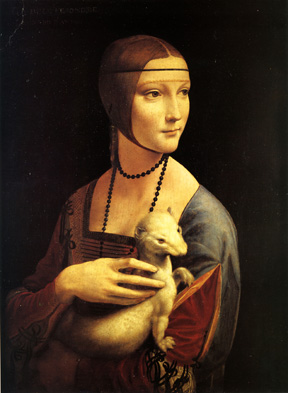Art Review: Gesichter der Renaissance - Faces of the Renaissance
Masterpieces of Italian Portraiture
images courtesy of the Boden Museum, Berlin, Germany
 Leonardo da Vinci Lady with an Ermine (portrait of Cecilia Gallerani), 1489/90 Kraków, owned by Princes Czartoryski Foundation, at the National Museum © bpk / Scala Leonardo da Vinci Lady with an Ermine (portrait of Cecilia Gallerani), 1489/90 Kraków, owned by Princes Czartoryski Foundation, at the National Museum © bpk / Scala |
By J. IWAN, PhD
ART TIMES online December 2011
On October 27, my wife Jacky took the opportunity to snatch two of the last “early bird” tickets for the exhibition “Faces of the Renaissance”* at the Bode Museum on Museum Island in the very center of Berlin/ Germany. These tickets enabled us to get into the exhibition halls an hour before the regular crowd was let in, portion by portion. When we arrived at the Bode Museum next morning shortly before nine o’clock, an unbelievable number of people had already queued up in front of the entrance — the line stretching beyond a distance of definitely more than 500 yards. As we passed all these unfortunate art lovers waiting for their turn to be admitted to the exhibition, I was even more grateful to Jacky for having obtained our special tickets, which saved us an incalculable waiting period. The exhibition is a cooperation between the Bode Museum in Berlin and the Metropolitan Museum in New York City, and it unites for the first time unique masterpieces of (mainly) Italian portraiture of the Renaissance era from both locations, Berlin and New York. Therefore, after closing down over here on November 20, the majority of the exhibit will travel to the Metropolitan Museum, which is going to show them from December 19, 2011 to March 18, 2012.
 Antonio del Pollaiuolo Portrait of a Young Woman, c 1465/70 Milan, Museo Poldi Pezzoli Antonio del Pollaiuolo Portrait of a Young Woman, c 1465/70 Milan, Museo Poldi Pezzoli © Museo Poldi Pezzoli, Milan |
The collection gathered for both above-mentioned events comprises paintings, drawings, sculptures and portrait medals, which for several reasons were very popular in the 15th century at Italian courts. Altogether, the exhibition is structured geographically, with Florence, Milano, Rome and Venice being the focal points. In my opinion, this grandiose assembly of Renaissance art work strikingly demonstrates the transition from medieval to modern painting and sculpturing. Paintings of Raphael, the Pollaiuolo brothers and ‑— above all — Leonardo da Vinci (just to name a few) illustrate this development quite clearly. It is reflected not only by technical details (e.g. change from tempera to oil or change of the visual angle from full profile to half profile) but also, and most importantly, by the intention of the artist, not just to create a more or less superficial similarity to the person depicted but also to unveil characteristic properties of his/her soul and the feelings prevailing at moment caught in the respective representation. All this is most obvious in Leonardo’s painting "The Lady with the Ermine”, which is the undisputed highlight of the entire exhibition. Unfortunately, this piece will not be shown in New York since it has meanwhile been shipped to London/GB and is going to return to the Czartoryski Museum in Krakow/Poland afterwards. But even without Leonardo’s Lady, the exhibition is an absolute must, as in the face of all these masterpieces the eternal question — what is art, and what not?** — becomes irrelevant. So much to whet your appetite for the upcoming exhibition in the Metropolitan Museum.
*(Venues: Berlin, Bode Museum, August 25, 2011 - November 20, 2011; New York City, Metropolitan Museum, December 19 - March 18, 2012)
**As a layman, my own definition of art is this: Everything I couldn’t do better.
(J. Iwan, PhD., lives in Berlin, Germany).
